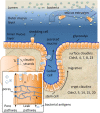Layered defense: how mucus and tight junctions seal the intestinal barrier
- PMID: 28707083
- PMCID: PMC5548832
- DOI: 10.1007/s00109-017-1557-x
Layered defense: how mucus and tight junctions seal the intestinal barrier
Abstract
The colonic mucosa provides a vital defensive barrier separating the body from the microbial populations residing in the intestinal lumen. Indeed, growing evidence shows that loss of this barrier may cause disease or exacerbate disease progression. The loss of barrier integrity increases the translocation of bacterial antigens and stimulates inflammation in the intestinal mucosa, which is the central pathological feature of inflammatory bowel diseases (IBDs). This review focuses on how intestinal mucus and intercellular tight junctions (TJs) act together to maintain the integrity of the colonic barrier and how barrier integrity is dysregulated in IBD.
Keywords: Epithelial barrier; IBD; Inflammation; Mucus; Tight junction.
Figures

References
Publication types
MeSH terms
Substances
Grants and funding
LinkOut - more resources
Full Text Sources
Other Literature Sources

